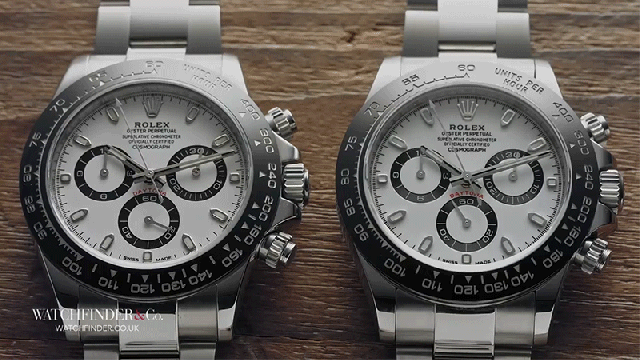At one point in time, it was easy to spot a fake Rolex, as most knock-offs used a non-mechanical Quartz movement inside that resulted in a stuttered ticking movement of the watch’s second hand. But as the experts at Watchfinder & Co. discovered, that’s far from the case today. The best Rolex fakes can be almost impossible to spot, even for expert collectors.
There are many aspects of a luxury mechanical timepiece like a Rolex that make it desirable, and incredibly expensive. The design, the accuracy of the mechanical movement, the complications and extra features all add to the value of a timepiece. But it’s the attention to detail, the craftsmanship, and the hundreds of hours of manual labour required to give it the perfect finish that really accounts for a watch like the Rolex Daytona 116500LN’s $US10,000+ ($14,351)+ price tag.
In the past, forgers attempting to get a similar looking timepiece to market wouldn’t put nearly as much attention to detail into their fakes. Instead, they relied on machines to quickly stamp out parts and components en masse. The results were cheaper, and they definitely looked the part. But times have changed, and the improved accuracy and precision of milling machines and other automated manufacturing processes have allowed forgers to create fake Rolexes with impressive accuracy—even when directly compared to the real thing, as Watchfinder & Co. demonstrates with two versions of a Rolex Daytona 116500LN.
By itself, the fake Rolex Daytona does almost everything right, to the point of using the same steel as the real thing for its case and bracelet, actual ceramic in the bezel surrounding the watch face, and a near-perfect replica of the Rolex’s mechanical movement inside. Where it falls apart is when you really start to study the fit and finish of the fake. Rolex still relies on skilled craftspersons for many parts of its manufacturing process, resulting in highly polished finishes and smooth detailing, which the mass-produced fake is lacking. The details are subtle, but even the lettering on the watch face looks a little sloppy and uneven compared to the real deal.
What’s even more interesting is that this level of forgery doesn’t come cheap. The fake Rolex Daytona 116500LN still costs well over $US1,000 ($1,435)—but at that price point, you’re actually getting a really decent timepiece that should keep time almost as well as a real Rolex does—and saving almost ten grand in the process. Avid watch collectors would undoubtedly look down at someone sporting a fake like this, but would the rest of us really care? The skill and tricks the forgers now employ to copy a Rolex almost give the fake as compelling a backstory as a genuine Rolex that’s been handed down through a family for generations.
With smartwatches eclipsing what a mechanical watch is capable of, wearing an old school timepiece is now even more about what it means to you, or the story of the watch itself. And at this point, what the forgers have accomplished is both impressive and fascinating. Should you actively seek out a forgery? Absolutely not, but if someone told me they were wearing a flawless Rolex fake, I’d probably be more interested in hearing about the forgery than the genuine article.
